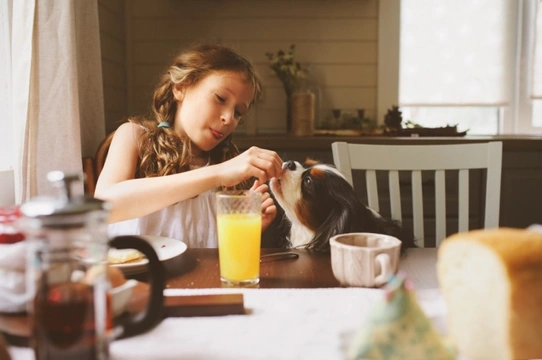
Can you give your dog bread?
Bread is a food staple that most of us eat fairly regularly, but it also has a fairly low nutritional value and reasonably high calories, a trait that is unfortunately shared by a great many other delicious foods too!
Dogs will often beg for bread and most dogs would make serious inroads on a dropped sandwich without batting an eyelid; so can you give your dog bread safely, and is it a problem if your dog eats bread by accident? The simple answer is that it depends on the bread.
For a rather more complete and useful answer, read on to find out if bread is safe for dogs.
Is bread safe for dogs?
This is a question without a straight answer, because it depends on the type of bread.
Plain brown or white bread given in a small amount now and then is safe for dogs, assuming that your dog is not one that has a wheat or gluten allergy of course. Wheat allergies in dogs are not common across the canine population as a whole, but this is one of the more common allergens for dogs overall.
Additionally, a lot of bread has other things added to it that are themselves toxic to dogs, and so what else is in the bread can potentially mean that it isn’t safe for dogs and could contain something quite dangerous.
However, even when it comes to that plain white or brown bread we mentioned initially, bread is high calorie and contains few nutrients, and so it certainly isn’t good for dogs either.
Also, if you’re talking about bread that has been buttered or had any other type of spread put on it, whether or not it is safe becomes a wide-open question once again. Butter is not toxic to dogs but it is very high in fat and also salt, and so feeding something like this will quickly contribute to a dog’s weight gain and may even be rich enough to upset their stomach if the butter is thick and the dog eats enough of it and/or is very small.
Chocolate spreads are toxic to dogs, and things like peanut butter, while not toxic (assuming they do not contain artificial sweeteners) are again high calorie and very fatty, and so not good for dogs on their own, far less when fed on bread.
What type of bread is dangerous to dogs?
In terms of the types of bread that can be outright dangerous to dogs – with the caveat that bread in general isn’t good for dogs – there are quite a few things that are added to various types of loaves people like to make at home or buy at the shops that can make the bread it is contained within outright toxic to your dog.
Sweet breads (often brioche, sweet loaves and so on) that contain chocolate chips or raisins – and this includes things like hot cross buns and potentially other seasonal goods – are toxic to dogs. Also, while it is not hugely common, some sweet breads are sweetened with artificial sweeteners too and so this is itself toxic to dogs.
Savoury breads sometimes contain onion or garlic (focaccia and ciabatta often does) which are also toxic.
Macadamia nuts are toxic to dogs too and even these are popular in some breads with nuts added.
Uncooked bread dough of any type is very dangerous to dogs
As you can see, deciding if any sort of bread is toxic to dogs can be quite complex, and the specific types of bread mentioned above are by no means exhaustive in this respect. However, that still leaves a reasonable number of baked breads that are safe for dogs, albeit not strictly good for them.
When it comes to bread dough though, if you make bread at home, this is actually very dangerous for dogs, even if the bread it will ultimately make is itself safe.
If you do make bread, you will no doubt already know that yeast is required to make the bread rise and that it achieves this via fermentation. This is why we often leave bread sitting out to rise; but if your dog eats dough it can continue to expand in their stomach (the warmth and moisture making for an ideal environment for this) and it can also release fermentation alcohols, which are themselves very poisonous.
Eating raw bread dough can make a dog very sick, causing stomach distention and bloating that is acute and very painful, and that can itself be life threatening; as can the production of alcohol from fermentation in the stomach, which is highly toxic and can poison your dog.
Do dogs like bread?
Most dogs will eat bread if offered it just as most dogs would eat most things that are fairly neutral or that actually smell of or contain something that they like.
Only dogs that are fairly picky eaters in general tend to turn their noses up if offered bread, which means that you not only need to think carefully about giving your dog a piece of bread deliberately, but also the chances that they might help themselves if bread is left within reach, and whether or not that bread might be one of the toxic kinds.



